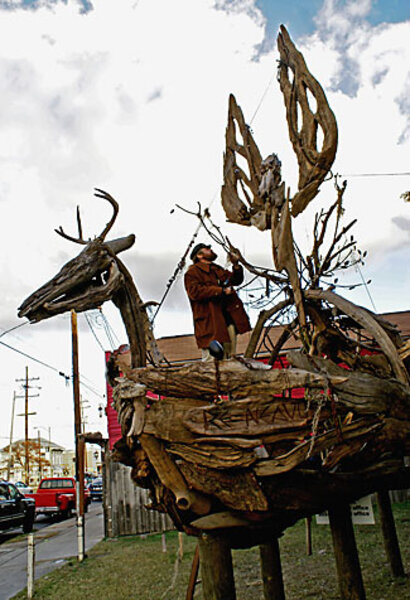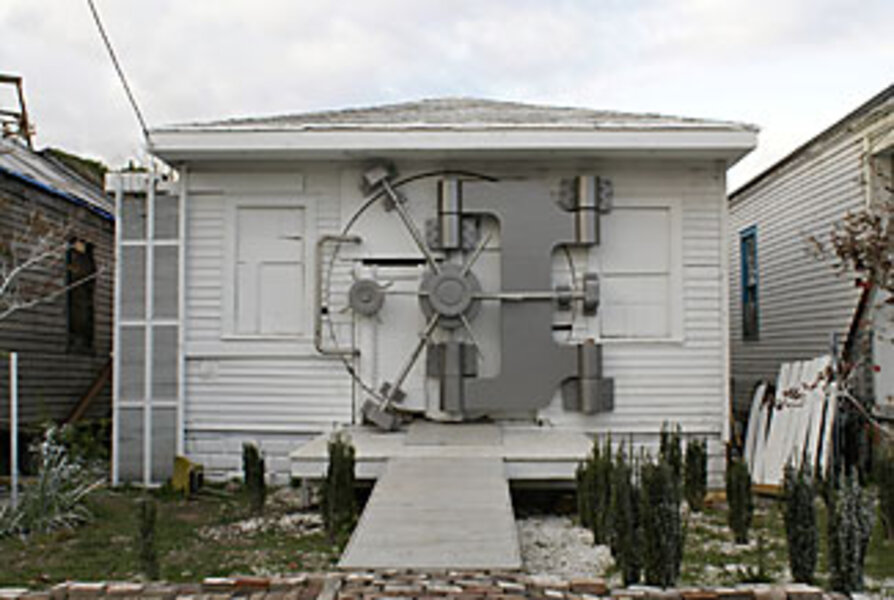Big Easy's new biennial energizes arts community
Loading...
| New Orleans
Art has often been championed as a vehicle for urban redevelopment, and perhaps in no other recent time and place has the notion been so tested as it is now in New Orleans. On St. Claude Avenue in the city's Ninth Ward, where a new international art biennial is vying for attention with a resurgent local art scene, it seems to be working. While the project is still an endeavor in progress, the once-blighted neighborhood has a palpable energy and excitement and is making significant strides, with art at center stage.
Billed as the largest exhibition of contemporary art ever held in the United States, the new biennial, called Prospect.1 (www.prospectneworleans.org), has brought 70 international visual artists to the still-recovering city. High-flying art collectors and museum officials were in attendance for its Nov. 1 opening, and the biennial is expected to draw 50,000 visitors through its close on Jan. 18. Exhibition spaces range from the Contemporary Arts Center – where works by 20 artists, including Cuban painter Luis Cruz Azaceta, young Chinese artist Cao Fei, and Amsterdam-based photographer Fiona Tan, are displayed on four floors – to empty lots in the hurricane-ravaged Lower Ninth Ward. There Argentine artist Leandro Erlich's "Window and Ladder – Too Late for Help" offers a surrealist-inspired take on disaster response, and Jamaican-born sculptor Nari Ward has created one of her cubist installations of reclaimed objects inside a gutted Baptist church.
Organizer Dan Cameron, visual director of the New Orleans Contemporary Arts Center, conceived the biennial as a way to give the visual arts a higher profile in the city's rebuilding efforts, while raising New Orleans' profile in the art world.
The biennial is truly a citywide event, with hundreds of residents participating as volunteer organizers and docents. In a place where spectators quickly become the main action of any parade, an expected consequence of Prospect.1 has been a parallel outpouring of effort from native artists and local galleries that rival the best of the biennial.
One example can be found on
St. Claude Avenue, where a whimsical chimera constructed from driftwood – equal parts seagoing ark, mythical creature, and shamanic altar – rises from an empty lot across from Charles J. Colton Junior High School. On a recent afternoon a child from the neighborhood stopped to ask if it could fly. "Sure, it flies in your head, in your imagination," artist Herbert Kearney answered. "You're the kid – you tell me if it flies."
Created by Kearney and fellow artists Joshua Walsh and Jules Cote, their work is a "guerrilla art drop" coinciding with the official exhibits of Prospect.1. Undeterred when they failed to win inclusion in the biennial – only 11 Louisiana artists did – Kearney and his collaborators worked for months before making their unsanctioned installation two days before the biennial's opening. Their volunteer crew included a dozen local poets, artists, and musicians. "New Orleans is one of the few places left where something like this can happen, where it's all about the art and living the life of art," says Kearney. "The 'condo mondo' world hasn't taken over here yet, and the city itself is a beautiful canvas to work with."
St. Claude Avenue, which was down on its heels before Katrina but did not suffer severe flooding, has been ground zero for a flowering indigenous-arts scene. Eight new galleries have opened in the past three years. At Colton Junior High School, where several Prospect.1 artists have installations, more than 50 local artists associated with the Creative Alliance of New Orleans have set up studio spaces and informal galleries. The city's public school system offered temporary use of the building to CANO, in return for volunteer renovation work and free art classes for public school students.
A block away, an equally innovative collaboration is taking shape in an old furniture store, where the St. Claude Collective – a group of artists, architects, builders, and alternative healers – is turning the once-vacant building into a community center and exhibition space. In an arrangement that might be considered odd in most cities, the New Orleans police department became the collective's first tenant, opening a district substation on the first floor.
Across the street on St. Roch Avenue, artist Ann Linn has a hand in two art galleries housed on her corner property. A Mississippi native and fabric artist who lived in New York for 20 years before moving to New Orleans after Katrina, Linn runs the Home Space Gallery and rents an attached Creole cottage to artists.
A few blocks away at the other end of St. Roch, art entrepreneur Kirsha Kaechele runs KKProjects, which encompasses an art gallery built in a former bakery and four dilapidated shotgun houses that she offers to artists for installations. While not an official Prospect.1 site, Kaechele's recent outdoor dinner party, which seated 250 art patrons at a block-long dinner table, nearly stole the spotlight of the new biennial's opening night.
New Orleans' fertile creative soil and comparatively low cost of living have always attracted artists, and the opportunity of redeveloping a devastated city is also drawing some high-profile art and design professionals.
"When young artists ask me where they should go to work, I mentioned two places – Berlin and New Orleans," says artist Willie Birch, a native who spent two decades in New York before returning, and whose work is part of Prospect.1. "The visuals here are crying to be made into something that's very unique.... Things are just beginning to buzz here in terms of possibility."







